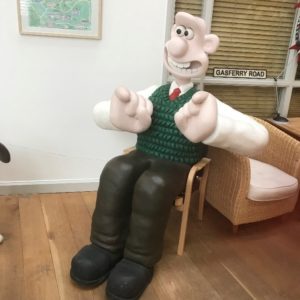
Aardman was founded by Peter Lord and David Sproxton in 1972. Films such as Chicken Run and Wallace & Gromit: The Curse of the Were-Rabbit have become classics, and Morph, Wallace and Gromit and Shaun The Sheep have surely become national treasures.
Indeed, when you visit their offices, Wallace is there to greet you:

In 2018, Peter and David sold Aardman to an Employee Ownership Trust (EOT). I recently sat down with David Sproxton to find out their motivations, and the process that they went through.
Making Time
Peter and David had been considering the future of Aardman for some time, and came across the concept of employee ownership around eight years ago. They got serious about investigating this as a potential exit route 4 or 5 years ago, and Aardman joined the Employee Ownership Association (EOA) in 2014. David attended the annual EOA conference twice before selling to the EOT. He found the conference extremely valuable in enhancing his knowledge and understanding of the whole employee ownership philosophy.
David took the lead in the process and blocked out one day a week in his diary. Although he didn’t always use this day, David says that this is his biggest tip for anyone thinking about succession of their business. By taking this time out, he was able to build a roadmap of all the things they needed to do for they would feel able to sell the business to the EOT.
Having made their investigations, Peter and David decided that the EOT was the ideal solution for them, allowing them to leave a legacy for the business, and yet still exit the business for a fair price. They then set about preparing the business for the transition to employee ownership.
Big-Ticket Stuff
David set up a small EOT Project team at Aardman and they began looking at the big issues, the first of which was a legacy document (what we refer to in the Eternal Business Programme as the Flag). Both Peter and David wrote pieces encapsulating their philosophy about the business and the purpose of Aardman. The company already had mission and Vision statements, which David broke down and qualified. These became the Guiding Principles for the company.
Next came the more legal Constitution document, looking at how the company will operate once it is owned by the EOT. The pathways of control, how decision making would work, who would be trustees, and so on.
They began the employee engagement process early, telling the employees that they were thinking about the EOT. A year or so later in April 2018, they informed the employees that the EO transition would happen at the end of October 2018. This allowed the staff to get used to the idea and also started the discussions about how to incorporate the valuable body of freelancers Aardman employs to be part of the process.
All of the above were aided with the assistance of employee ownership specialists. The final big-ticket issue was to engage legal help to sort out the new company structure, commission corporate valuations, and tie up all the legal short ends.
Employee Reaction
With around 140 employees and up to 180 freelance contractors, engaging the employees required real planning. Positive returns had been seen from the work done prior to the sale, however, David quotes attendance at Employee Ownership Association (EOA) by the recently created Aardman Partner Representative Group as being crucial to their positive approach.
Meeting employees of other companies who have been employee-owned for some time is transformative in helping employees to understand not only the benefits of being owned by an EOT, but ways in which an EOT owned business is different from a privately owned business.
Aardman has produced an employee handbook to help with the understanding of the concept, and, in particular, the new structure. For example, one document outlines who will be able to answer what kind of question within the business. This can be particularly important to clarify the role of the trustee as being representative of employees as owners, and not to be acting as a shop steward.
Looking Back
As he looks back on the process that they have been through with Aardman, David offers the following three specific tips:
1. Set aside time. There always seems to be something else to do, which can result in dealing with succession planning getting put off. Mark out time in the diary and make sure you stick to it
2. Engage a whip-cracker. Despite best intentions, the pressures of work meant that the jobs will be put aside, the issues left unaddressed. By employing employee ownership specialist consultants and lawyers, they were able to keep things moving
3. Do your homework and then mull it over. Selling your business is a major decision, and selling to an EOT is a big commitment. Take your time to be clear that this is the right route for you, and then take time to make the early preparations
What Next
David is confident that Aardman is now in good hands. Having seen first hand the buying and selling of businesses at the biggest possible level in Hollywood, he is happy that Aardman is in the hands of people who will look after it for the long term – its employees.
As for himself, David is aware of the importance of clarity of the role of the founder in a newly employee-owned business, and plans are in place to replace him in time. In the meantime, is enjoying mentoring young creatives in Bristol, and helping employees of Aardman take the business forward.
Course 1 of The Eternal Business Programme is for owners to understand the EOT route fully, and then make the early preparations. Find out more about the programme here or email us at chris@theeternalbusiness.com.
We also offer consultancy services to help owners and leadership teams get ready – if you’d like your very own whip-cracker, do get in touch!







